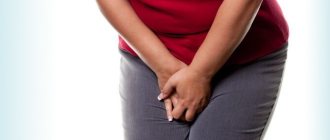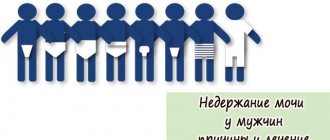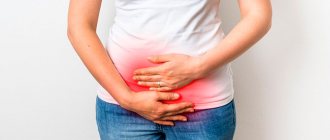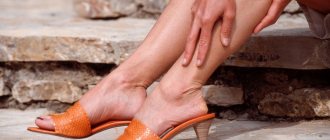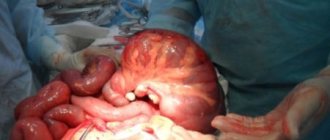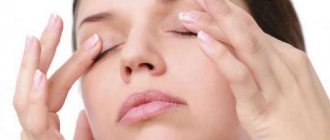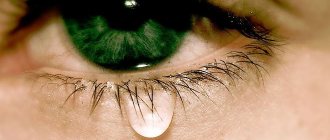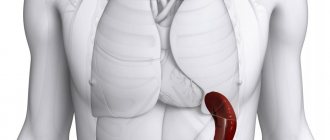Today we will learn the reasons that lead to such a disease as urinary incontinence (incontinence) in women, men and children, as well as various methods and means of treating the problem. Many people try to hide urinary incontinence, considering it something shameful and unpleasant. However, urologists unanimously assure: it can and should be treated, and without delay. The longer you remain silent about the problem, the more serious it becomes. Incontinence involves a lack of control, resulting in feelings of shame and reluctance to seek medical attention. One study found that 55% of women who wore incontinence pads did not see a doctor for a year.
Fortunately, there have been major breakthroughs in the treatment of this disease over the past 20 years. If the patient seeks help when the incontinence is not yet severe, he has a much greater chance of success from treatment. The more severe the disease, the more difficult and expensive it is to treat.
Urinary incontinence in women: causes and treatment
Urinary incontinence or involuntary urination is considered mainly a ladies' problem. It is relatively rare in men, which is due to physiology - women's pelvic floor muscles are much weaker.
Involuntary urination in women is a disease that is accompanied by uncontrolled leakage of urine. It occurs when control of the bladder muscles is lost.
Most often, this disease affects women who have undergone childbirth. But not only. For example, the ratio of manifestations of the disease in Australian women and men is 37% and 13%, respectively (it was there that a detailed calculation was carried out).
Mild urinary incontinence is the most common form of the disease and is found in 2 out of 3 patients with this condition. The mild form is characterized by the leakage of small amounts of urine (maybe even a few drops) onto the underwear several times a week and requires the use of tampons or pads to prevent leakage.
Moderate and severe incontinence are less common and affect about 1/3 of patients. Such women are forced to use special pads (with absorbent gel) and change them more than once or twice a day. However, this may not be enough, and accidental “spraying” of urine on clothes may occur, despite the use of special pads.
Whatever form it may be, it has a great impact on women, debilitating them. At the same time, women are often embarrassed to consult a doctor with this problem. This is sad because the sooner a woman applies, the more likely it is that treatment will be successful.
Types of involuntary urination in women
To determine the causes and probable ways to get rid of involuntary urination, first of all, you need to figure out what type of illness you have. There are three main types of urinary incontinence:
- Stressful. It is caused by increased intrauterine pressure. Stress incontinence occurs when urine leaks when you laugh, sneeze, cough, or exercise. People with this type of incontinence have weak muscles around the urethra that become overstrained during certain physical activities.
- Call sign (imperative or urgent). It is caused by an unbearable urge to urinate, which is almost impossible to restrain. When a patient experiences the second form, urge urinary incontinence, the person experiences an urgent need to go to the toilet, which occurs due to spasms in the muscles of the bladder. As a result of such a spasm, uncontrolled flow of urine can occur. These patients go to the toilet more than eight times a day and get up more than once to go to the toilet at night.
- Incontinence due to overflow (paradoxical ischuria). This form of the disease is more often observed in men with an enlarged prostate gland. In this case, the prostate partially blocks the urethra (urethra), so that the volume of residual urine in the bladder increases, and when it overflows, it flows out. In females, paradoxical ischuria occurs if the bladder prolapses or sinks into the vagina. In this case, the urethra is blocked, which, as in the case of men, leads to incomplete emptying of the bladder, and subsequently to involuntary urination.
Approximately half of all situations of urinary incontinence in women tend to be of the first type, and the same number - to the second. In young women, stress urinary incontinence occurs in 28%. Most of them are involved in certain sports (gymnastics, tennis or basketball). Between them there are rare exceptions and mixed variants.
You may find an article on a related topic useful - the causes of urinary incontinence in women, or you are interested in how to get rid of heartburn during pregnancy, as well as how to cure a cough with folk remedies. Good advice awaits you in the article on how to determine pregnancy without a test and treatment of chlamydia - follow the links. You will learn a lot from the article, which describes mammoplasty or breast plastic surgery.
Causes of leakage in women
Young girls are confident that they will definitely not encounter a similar problem in the coming years, considering involuntary urination to be the lot of older people.
However, age is not the only factor here, and quite young ladies often suffer from involuntary leakage. For example, during pregnancy, when the rapidly growing uterus begins to put diligent pressure on the bladder. There are other common causes of this unpleasant illness:
- Hormonal imbalance or menopause. The less estrogen is produced in the body (usually this occurs during menopause), the worse the situation with the genital mucosa and tissue elasticity. What ultimately provokes urinary incontinence in older women and women with early menopause.
- Typical urinary incontinence after childbirth (stress) is associated with trauma, perineal tears and weakening of the pelvic muscles. The most common culprits are rapid, second/third or very prolonged labor.
- Untreated infections are a common cause of involuntary urination.
- Often, incontinence in women after 50 years of age is caused by changes in the cerebral cortex . In fact, the mind ceases to carefully control urination. The root causes of such dramatic changes may be a stroke, atherosclerosis, or prolonged diabetes.
- Neurogenic factors (brain diseases or brain injuries) lead to the urgent type of incontinence.
- Surgeries performed on the uterus or ovaries can leave behind the same unpleasant consequences.
There is also a unique risk group . You are much more likely to know first-hand about urinary incontinence if your mother or grandmother suffered from it (heredity), if you are overweight, have bad habits (smoking) or experience constipation from time to time. In order not to run into trouble, it is worth carrying out prevention.
Only 30% of women suffering from incontinence turn to a specialist (urologist or gynecologist) for help. The rest either do not believe in the possibility of deliverance, or fight the disease with folk remedies. Some, out of despair, turn into recluses, limit contact and stop leaving the apartment. But this is not an option: even those whose disease has reached the chronic stage can lead a normal life using special large pads.
Incontinence and patient age
Women are more susceptible to urinary incontinence because their urethra is very short (only 4 cm), while men's urethra is quite long at 11 cm. Think of it like a garden hose: the shorter it is, the more likely it is that water will leak out. the tap will leak. In a long hose, on the contrary, tap water may even stop flowing before reaching the end.
About 1/3 of women who give birth suffer from urinary incontinence for some time. Teenage girls and children also experience urine leakage, mainly due to bedwetting (enuresis). This is due to increased bladder activity. This form of urinary incontinence affects about 4% of children aged 5 to 12 years.
Bedwetting decreases by adolescence, but urgency and stress urinary leakage persist in approximately 10% of women. Uncontrolled leakage becomes more common after menopause as a woman produces less estrogen, causing the pelvic floor ligaments and muscles that support the urethra to become weak.
Obesity also increases the likelihood of incontinence because abdominal fat puts pressure on the pelvic floor muscles. In addition, constipation and straining weaken these muscles, thereby increasing the risk of developing the disease.
Anxiety also contributes to the development of symptoms, with research showing that between 28% and 32% of women with urge incontinence and 22% with stress incontinence suffer from anxiety.
Urine incontinence in women aged 50 and over 50 years is in most cases caused by hormonal changes that occur during menopause. It is impossible to exclude oncology of the urinary system, a stroke, when the functioning of the peripheral nervous system, which controls the emission of the urethra, is disrupted. In smokers with chronic cough, the muscles of the peritoneum and bladder weaken and, as a result, incontinence occurs.
Dr. Kartavenko offers an interesting treatment for women after menopause:
How to treat urinary incontinence, what to do
To begin with, do not hesitate to seek help from a gynecologist or urologist. The doctor will try to determine the cause and type of your specific illness. To do this, he will perform several manipulations, ask you to take a “cough test” and take some tests.
For women, the procedure for making a diagnosis is as follows:
1. Collection of information. The doctor will ask you in detail about how much liquid you drank and how much was excreted. He may ask you to keep a urination diary. 2. Examination in the gynecologist's chair. 3. He will ask you to cough to see if it produces urine. Involuntary urination when coughing hints at a stressful type of problem. 4. Taking smears. 5. Urine tests (according to Nechiporenko, general and culture). 6. Exclusion of cystitis and other inflammatory diseases. 7. Ultrasound of the kidneys. 8. Additionally, cystoscopy (evaluation of the bladder mucosa) or urofluorometry may be needed.
Then the doctor selects individual therapy. Among the most popular methods of treating urinary incontinence is conservative physiotherapy (for example, electrophoresis). Progressive injections of botulinum toxin directly into the mucous membrane of the bladder (botulinum therapy) have proven themselves to be effective.
Surgery or medications, what will help?
Medications. Often, a gynecologist or urologist prescribes treatment with medications: tablets, ointments and other means. It includes antispasmodics and antidepressants. Among the well-known remedies is the drug “Driptan” and its analogues.
It is also important to get rid of the preconditions for the problem in time - constipation, excess weight, bad habits, and establish a regime of regular, but not too frequent trips to the toilet.
For urge incontinence, the main treatment is education to increase bladder capacity. Along with training, pills or a special patch are prescribed. At the same time, you need to understand that the duration of treatment will be from 3 to 6 months.
Involuntary urination after menopause is treated with a vaginal cream containing estrogen, which helps strengthen the urethra and increase bladder capacity.
About 40% of women who do not respond to this treatment have a urinary tract infection (cystitis). Other treatment options are being developed. For example, a randomized trial is currently underway on the use of bladder-specific antibiotics along with drugs that reduce bladder muscle spasm.
Surgery. After a year (if unsuccessful), surgery may be scheduled. The most widely used operation is when a mesh or tape is sutured under the urethra and creates support for it. This is the so-called sling operation. With the help of loop (sling) plastic surgery with synthetic material, a reliable support will be created for your bladder, and the problem with leakage will disappear.
About 93% of women were cured 3 years after surgery. This method also shows good long-term results.
The operation takes place under local anesthesia, so you don’t have to worry about it. In a month you will return to normal life, including sports and sex without any restrictions.
Exercises to treat involuntary urination
One of the leading treatments for stress incontinence is pelvic muscle training, which can be taught by a physical therapist. At the same time, there is a 65% chance of cure for mild and 35% for moderate urinary incontinence without side effects or any risks.
Doctors realize how delicate this common problem is, urinary incontinence in women: treatment at home is available and possible. Regular physical exercises help many (the familiar “birch”, “bicycle”, “scissors” and others based on lifting the pelvis from school). This will strengthen your abdominal and pelvic muscles.
Quick and lasting results are brought by Kegel exercises, which every pregnant lady knows about, and training for intimate muscles with internal “weights” (balls that will have to be placed in the vagina). Regular exercise on your own sofa will help you effectively fight the disease.
Exercises with vaginal cones are considered effective for women. In a standing position, the lady places a light weight cone into the vagina and uses her muscles to prevent it from falling out. The further your training progresses, the more weight you can take. The same muscles are used to control urination, therefore, by “pumping up” and strengthening them, you can forget about the problem of leakage for a long time.
If this doesn't work, there are two types of intravaginal urethral support devices. This is especially useful for women who developed the disease due to active sports.
Aids for leakage in women
Until therapy is completed, the patient has to resort to tricks in order to live a full life. Fortunately, today the market for hygiene products is unusually wide. Anyone who suffers from incontinence should purchase special urological inserts and disposable panties. They will not only solve the problem of noticeable leakage and save your clothes, but will also take care of the delicate skin of the perineum, relieving it of irritation and unpleasant odor.
Urological pads are suitable for women; men should purchase special sanitary underwear for these purposes. In addition, self-adhesive urocondoms have been created for the stronger sex, allowing you to hide the problem in the most delicate way.
In advanced cases (at home), disposable absorbent diapers and special diapers/panties for adults are relevant.
Anyone who has a problem with involuntary urination should wash themselves more often with gentle intimate hygiene products. On the road or at work, soft wet wipes with an antiseptic effect or moisturizing gel (for example, for children) will help. In case of irritation, you should lubricate the skin with a healing cream.
Important: to prevent urine from irritating the skin and not having an extremely unpleasant aroma, you should drink 2 liters of liquid (per day). Many people reduce the norm, fearing frequent leakage, but this only aggravates the situation.
No woman suffering from this unpleasant illness should hide the disease and suffer alone with herself. The above procedures are not that complex, but they require a professional approach in order to consider all possible treatment options for a particular woman.
Advertising MEDICINETEASER
What to do, which doctor to go to?
Of course, a woman with this problem needs to visit a gynecologist who will perform a gynecological examination, prescribe an ultrasound of the genitourinary system: kidneys, ovaries, uterus, etc., functional tests, urodynamic studies and urethrocystoscopy.
Conservative therapy for stress, nocturnal and other forms of urinary incontinence may include special exercises for training the pelvic floor muscles (Kegel exercises), electrical stimulation, treatment with a variety of medications, drugs, procedures and means, including the use of folk remedies at home. If conservative treatment is ineffective, surgical operations, including sling operations, are prescribed.
Urinary incontinence in women after 30, 40, 50, 60, 70 years of age
As we have already said, urinary incontinence in women is the spontaneous release of urine from the urethra, caused by disorders of the mechanisms of regulation of micturition.
According to statistics, every fifth woman faces involuntary urine leakage at reproductive age - 30, 40 years old, every third woman at 50 years old - perimenopausal and early menopausal age (with menopause), and in old age (after 60, 70 years ) – every second.
The problem of urinary incontinence is more relevant for women after natural childbirth, as well as for pregnant women when coughing and sneezing (the fetus grows and puts pressure on the bladder). Urinary incontinence has hygienic, medical and social aspects. It has a negative impact on a woman’s quality of life and is accompanied by a forced decrease in physical activity. Neuroses, depression, and sexual dysfunction appear. Therefore, treatment should have an integrated approach from the perspective of psychotherapy, gynecology and urology.
Types of urinary incontinence in women
There are “true” (transurethral) and “false” (extraurethral) urinary incontinence.
In true cases, urine is excreted through the intact urethra, as it should be; with a false one - from abnormally located or damaged urinary tracts (this could be: ectopically located ureters, exstrophied bladder, urinary fistulas). Here we will consider true urinary incontinence - transurethral, which occurs in women in most cases, and false ones account for only 5 - 10% of cases.
Women experience the following types of transurethral urinary incontinence:
- imperative (urgent urinary incontinence, overactive bladder) – unbearable, uncontrollable urges caused by increased bladder reactivity;
- other (situational) forms - enuresis, urinary incontinence from bladder overflow (paradoxical ischuria), during sexual intercourse, etc.
- reflex-incontinence (neurogenic bladder) – spontaneous release of urine caused by impaired innervation of the bladder;
- mixed - combining signs of stress and urge incontinence (a sudden, uncontrollable need to urinate occurs during physical stress, followed by uncontrolled urination;
- stress – involuntary loss of urine associated with incompetence of the urethral sphincter or weakness of the pelvic floor muscles
- Iatrogenic – caused by taking certain medications;
Personal experience in treating a delicate problem
I have experience in this delicate issue. As always, something happens for the first time in life: a sneeze - and it’s time to change your panties... Shock! I thought it was an accident, but the further it went, the more tragic it became - the dog pulled a jerk while on a walk - and here it is - the result. I don't go to normal doctors. I contacted my herbal therapist by phone and took a certain course of products, which I started using at that time.
This is what the doctor recommended to me:
1. Drink the anti-stress complex Balance for at least three months in a row . I still use it regularly, there is no need to take breaks. Not suitable for hypotensive patients, but it suited me. At the same time, I took O.K. for a month. (osteo-complex) - after it, the sphincters are slightly strengthened thanks to calcium, magnesium and zinc ions.
2. But the result was rather unstable. I talked to the doctor again and remembered that I used to have chronic cystitis for a long time. I treated inflammation of the genitourinary system with the Sanklin complex (30 days in the morning and evening) and Freelife (the same dosage regimen). Significant improvement came right after a week of taking these herbal capsules. But as soon as I got a little nervous, I immediately felt worse. That's why I drink Balance without interruption.
3. In the third month, according to the regimen, I took Livesafe (liver support) and F. Aktiv (normalization of pancreatic functions). And the problem began to gradually go away. Unnoticed.
4. In the first half of the day I drank water with lemon juice (squeezed a little) - on an empty stomach in the morning and before lunch. I brewed lingonberry tea in a thermos (I bought lingonberries at the pharmacy).
5. I still remember that you can’t freeze - cystitis is so mild, not acute, it reminds you of itself and the sphincters become weaker. The jacket should cover your butt.
This is how I cope with stress urinary incontinence (leaking) with varying degrees of success and decided to share my experience with you. Why with a variable? You shouldn't be nervous at all! Freeze too! Otherwise, the priest had a dog...
Here is the doctor I consulted with and her story about Sanklin:
You can find the listed phyto-complexes on the Internet - this is the development of the Academy of Medical Sciences of Ukraine under the leadership of Professor Lapshin V.F. If you live in Russia, write in the comments that you need information and I will give you a link to an online store in St. Petersburg, payment upon receipt (friends have already taken it). I’ll say right away that I don’t make money from selling them, the stores are not mine - I just use the products.
Urinary incontinence in men: causes and treatment
How to treat a delicate problem in men? Gentlemen encounter it much less often than ladies, however, involuntary urination in men is much less treatable. The later the “stronger sex” consults a doctor (and pride and modesty do not allow this to be done in the early stages), the more difficult it is to deal with the symptom.
Main manifestations and symptoms in men
Depending on the severity of the disease, the abundance of discharge and the time of day, several types of male involuntary urination are noted:
- Leakage. After visiting the toilet and completing all the rituals, the gentlemen still produce a little urine (literally a few drops) for some time. This is physiological.
- Enuresis. Such bedwetting is typical for children; adult men suffer from it extremely rarely.
- Incontinence as such , that is, incontinence. Inability to control the urge to urinate.
It is the latter type (incontinence) that causes the most concern. In order to fight it and achieve a convincing result, it is important to recognize the disease that caused the development of the symptom in time!
Causes of involuntary urination in men
Just like in ladies, in gentlemen involuntary urination can be stressful, urgent or mixed. There are also postoperative types, temporary (caused by infection or “side effects” from taking medications) and “from overflow.” It is worth talking in detail about the causes of incontinence. These include:
- Bladder or ureteral dysfunction
- Various tumors of the genitourinary organs
- Consequences of operations (especially unsuccessful ones) on the prostate gland or pelvic organs
- Local blood supply disorders associated with old age
- Urinary tract infections (usually urethritis, prostatitis, cystitis)
- Stones in the kidneys, in the ureters
- Side effects (which are warned about in the instructions) from taking certain medications
- Consequences of prostate cancer treatment with radiation therapy
- Disorders caused by diseases of the central nervous system (stroke, multiple sclerosis and others), brain injuries or chronic intoxication (alcohol, drugs)
- Downward displacement of the abdominal organs so that they put pressure on the bladder. Reasons: sedentary lifestyle, permanent constipation, excessive physical activity that causes weakening of muscles
- Stress (usually chronic)
- Congenital defects
- Mental illness
- Genetic abnormalities
By the way, unlike the weaker sex, urinary incontinence in men cannot be caused by excess weight. Moderate intake of alcohol and caffeine also does not affect urination. But smoking is a serious provocateur of an unpleasant symptom.
As you already understand, with such an abundance of probable causes, you are unlikely to be able to make a diagnosis yourself. Sometimes, of course, involuntary urination in women (as well as in men) disappears on its own - as soon as the provoking factor (infection, medication) goes away. But more often, outside professional help is required, the patient’s patience and his optimistic attitude towards deliverance.
Treatment of leakage in men
Which doctor should you contact if you have a problem like this? If treatment is necessary, contact a urologist. To choose a strategy and design the right therapy, a thorough diagnosis will be required. It includes an examination by a urologist, an ultrasound, a survey of relatives and the patient, analysis of a urination diary for three days, urine and blood tests, and, if possible, endoscopic, X-ray and urodynamic studies.
If the disease is not very advanced, the doctor will offer you comprehensive conservative treatment. It includes:
- drug therapy with specially selected drugs
- dieting
- adjusting the rhythm of urination
- pelvic muscle training (Kegel exercises and others)
- physiotherapy
If conservative methods do not work, you will have to decide on surgery. The greatest results can be achieved by implanting a ring valve (sphincter) or a male loop (sling) made of synthetic fiber. Collagen injections are considered a slightly less reliable method.
Treatment of stress incontinence
In addition to the general incontinence treatments described above, treatment for stress incontinence requires the intervention of a physician. Conservative treatment with medications is not very popular, as it helps only in a small number of cases.
Drug treatment:
For mild stress incontinence, when the anatomical structures have retained their integrity, the following is sometimes used:
Adrenergic agonists (Gutron) increase the tone of the sphincter and urethra, but also affect vascular tone. They are used extremely rarely due to low effectiveness and side effects (increased blood pressure). Anticholinesterase drugs (Ubretide) also increase muscle tone. Recommended for women whose examination results have revealed bladder hypotension. The antidepressant Duloxetine (Cymbalta), effective in half of the cases, but has side effects on the digestive system.
Treatment of stress incontinence with tablets is very rare due to frequent relapses and side effects.
Urinary incontinence in children. Enuresis
In the situation with adults, the causes of involuntary urination can be very diverse, but with children everything is much simpler. Nocturnal enuresis in children is a very common phenomenon, because it is not so easy to curb the natural urge to urinate during sleep.
If in older women symptoms of incontinence occur mainly in women, then at a young age the opposite is true: there are twice as many boys suffering from involuntary urination as girls .
Up to five years of age (for the fairer sex - up to four), “wet diapers” are considered the norm . But long-term (school, teenage) enuresis is a good reason to see a doctor. At a minimum, to exclude unpleasant diseases from the list of suspects.
A child pees at night - what to do, reasons
Bedwetting in children over 5 years of age requires a thorough examination by a urologist, gynecologist, pediatrician and, if possible, a neurologist . In addition to tests, the child will be asked to do an ultrasound of the kidneys, cystography and uroflowmetry.
Childhood enuresis can be either primary (when it occurs exclusively at night) or secondary (the child does not control urine output, regardless of sleep and time of day).
Causes of urinary incontinence in children:
- Immature bladder or central nervous system (the child does not receive a signal that the bladder is full and cannot wake up in time and run to the potty)
- Severe stress (moving, parents’ divorce, going to first grade, mom leaving on a business trip, parents’ quarrels)
- Neuropsychiatric disorders (associated with hyperactivity, attention deficit disorder and similar behavioral problems)
- Infectious and other diseases of the genitourinary organs
- Hormonal disbalance. The culprit is antidiuretic hormone, the less of it is formed at night, the more urine is produced in the body
- Hereditary factor (my father could have had the same problem with wet sheets as a child)
One way or another, children’s involuntary urination needs to be combated – both psychologically and medicinally. However, there is no point in panicking and creating a restless atmosphere around the problem.
How to help a child with enuresis?
First, calm down. Wet diapers are not a big problem if the cause of incontinence is not a serious illness. Explain to the baby that he is not to blame, and you will not scold him for peeing. But if the night went dry, this is a good reason to praise your child.
There are traditional tips on how to avoid puddles as much as possible while sleeping:
- don't drink at night
- do not play actively before going to bed
- don't watch scary movies
- go to bed according to routine
- visit the toilet before turning off the light
- do not train him to go potty in the middle of the night (many mothers carry a half-asleep child in their arms, but in this case the children completely forget how to control the urge and wake up)
In advanced cases, the doctor will prescribe medications. As a rule, these are hormones, caffeine, psychostimulants, adrenergic agonists and antidepressants. Psychotherapy has proven itself well, including its non-trivial methods - such as communication with dolphins and horses or even hypnosis.
Communication with a regular school psychologist also has a beneficial effect on the child’s health - the main thing is to talk about the problem without hesitation. And treatment should begin with creating an emotionally comfortable climate within the family.
Urinary incontinence in the elderly
Pensioners are much less likely to go to the doctor with an unpleasant illness, considering it an integral part of old age. Indeed, problems with involuntary urination are much more common in older people than in younger people. But sometimes conservative and folk methods alone are enough to solve the problem.
Causes and treatment
At retirement age, involuntary urine leakage is usually provoked by spinal injuries, spinal cord diseases, neurogenic bladder, or tumors in the genitourinary system.
Classic urinary incontinence in women over 50 can be caused by long-standing birth injuries, previous surgeries, uterine prolapse or inflammatory processes in the genitals.
Treatment methods:
- physiotherapy
- medicines
- folk remedies
- botulinum toxin injections
- surgical intervention
Timely therapy will allow older people to abandon urological pads, forget about awkwardness and embarrassment and return to a full-fledged existence.
Classification of pathology
Urinary incontinence is the release of urine that is not controlled. The brain receives the signal to urinate late or not at all. Depending on the type of pathology, the cause of the incident is identified and treatment is prescribed. In medicine, there are four main types of incontinence, the list of which includes:
- Enuresis. Urine is released at night. It is during this period of time that the pelvic and sphincter muscles relax. During the daytime, the process of urination is normalized
- Stressful. Uncontrollable urination is caused by factors that affect the body as a whole, such as stress, exercise, sneezing, or involuntary contraction of the pelvic and abdominal muscles. In normal conditions, the sphincter of the bladder in women is tense. The pelvic floor is strong. However, there are certain psychological disorders that lead to its relaxation. As a result, any slight pressure and increased tone become the cause of involuntary urination.
- Urgent. Even if a small amount of urine has accumulated, a woman has a strong desire to empty her bladder. However, the signal arrives late. In this case, there is a loss of a certain amount of urine. Unlike other types of pathology, the bladder remains intact. The urethral muscles contract normally and offer resistance.
- Combined. This type of incontinence has signs of stress and urgency forms. This phenomenon occurs extremely rarely.
Regardless of the type of incontinence, a person experiences disturbances in the mechanism of relaxation and tension of the muscles of the urinary system.

